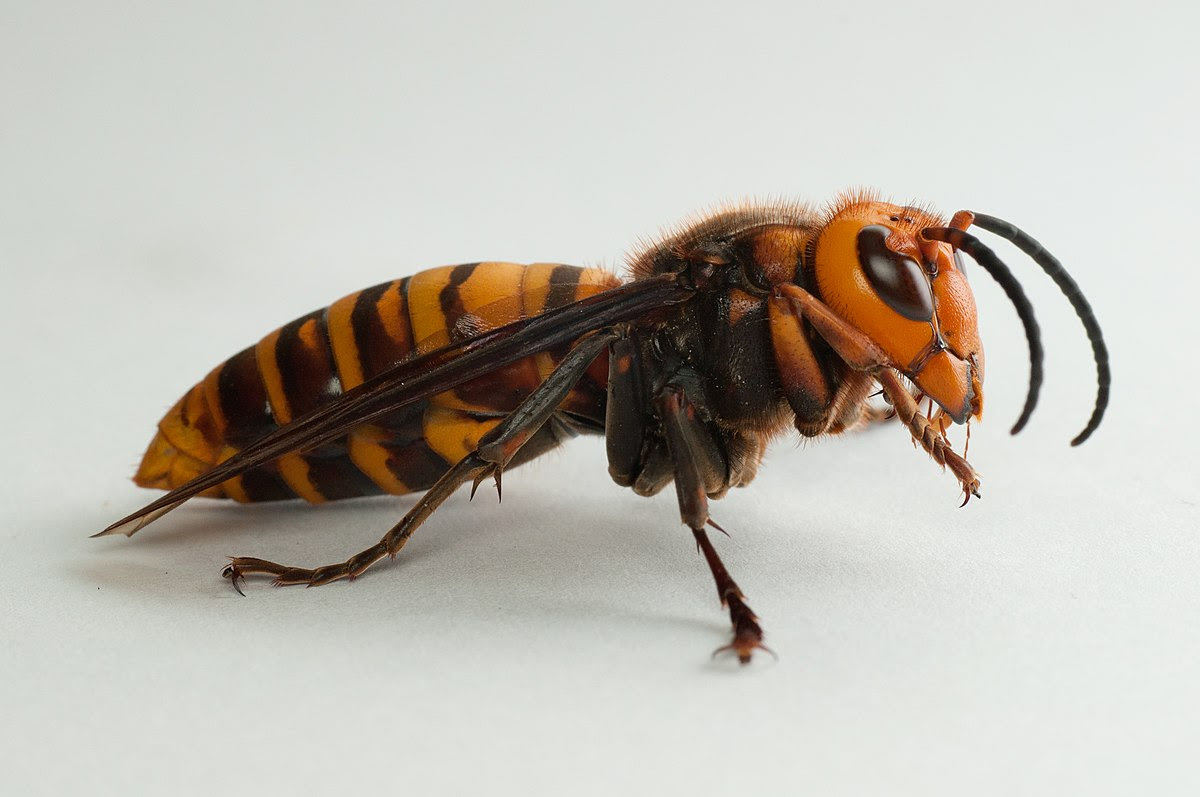
Male Vespa mandarina | Wikimedia
Setting the Stage
In October of 2013, there were reports 42 people killed in Shaanxi province, China and another 1,600 people injured as a result of insect stings — Asian giant hornet stings to be precise. In total, 206 people were hospitalized and emergency response teams worked around the clock to locate and destroy the nests of the giant hornet.
The Asian giant hornet, or Vespa mandarina, is the world’s largest hornet and can grow up to two inches long with a stinger that can extend nearly one-quarter of an inch. The venom from the sting, which is highly toxic, can cause shock and renal failure in some patients. They live in nests in rotted trees or underground and each nest can house as many as a thousand hornets and their larvae. Although these hornets are found throughout Asia, they are most commonly found in Japan.
In December 2019, the hornet was discovered in the Pacific Northwest of the United States. The Washington State Department of Agriculture (WSDA) identified the hornet near the Canadian border. It’s not known how long or where the hornet first arrived in North America, but insects are frequently transported unintentionally and sometimes deliberately in international cargo. Fortunately these hornets are typically not aggressive to humans, pets, or animals; however, if provoked they can produce a powerful sting resulting in occasional deaths. Also, they pose a threat to honeybees for which they have a voracious appetite. To see more about the sting, watch Coyote Peterson, a YouTuber, experience it first hand.
Threat to honeybees
In Japan, the hornet tends to feed on other large insects including native wasps and bees. It has caused significant devastation in Japan to the European honeybee, which has no effective defenses against the predator. Hornets tend to be most destructive in late summer and early fall. This raises concerns in the US where, similar to the rest of the world, growers depend on honeybees to pollinate many important food crops such as apples, almonds, and blueberries. In the context of Washington state, out-of-state beekeepers are reluctant to bring their hives to the state as they have seen the potential destruction they can have on local crops and ecologies from previous invasive species, like the spotted wing drosophilia fruit fly or the zebra mussels, according to WSU Extension entomologist, Todd Murray.
Recently in Washington state, on a routine check of some hives, Ted McFall noticed a mess of bee carcasses on the ground. On closer examination, it appeared that the bees had been “torn apart.” While uncertain for sure whether this was a result of the Asian giant hornet, their discovery last fall has him worried.
Scientists have started a full scale hunt for the invasive species as concerns grow that they could potentially decimate the bee population in the US. Chris Looney, an entomologist at the WSDA told the New York Times, “this is our window to keep it from establishing...If we can’t do it in the next couple years, it probably can’t be done.”
In Washington, the WSDA has put out a call to seek volunteers in the northwest of the state to help locate and trap the giant hornets. Teams of beekeepers and biologists are now working like detectives tracking the hornet hives. Dr. Looney says there are plans to possibly use radio-frequency tags to place on captured hornets and then monitor where they go to locate their nests and eliminate them.
International bee day
May 20th marks the third annual World Bee Day. In 2017, World Bee Day was submitted at the 40th Session of the Food and Agriculture Organization Conference and later the United Nations General Assembly unanimously proclaimed May 20th as World Bee Day. The idea behind World Bee Day was to draw attention to the essential role of bees and other pollinators in keeping people and the planet healthy.
Pollinators contribute directly to global food security, which is a cornerstone of the Sustainable Development Goals (SDGs). About three-quarters of the world’s major crop species depend, at least in part, on bees and other pollinators. Bees are intertwined throughout the rest of the SDGs as they help to provide food to a growing world (SDG 2) and preserve biodiversity and support healthy ecosystems (SDG 15). In addition, beekeeping provides jobs to farmers and contributes to building resilient livelihoods and agricultural infrastructure (SDG 1 and 9).
The appearance of the Asian giant hornet in the US does ring alarm bells. Although researchers are still uncertain of their impact on the bee populations, it does highlight the importance of protecting a species that contributes so much to our food security. These hornets are just one example of how a novel threat can impact the food industry. It is important that these threats are taken seriously as now, in the midst of the COVID-19 epidemic, we are seeing firsthand how novel issues can affect our food industry and people's livelihoods that depend on it.
United Nations
Food and Agriculture Organization of the United Nations
